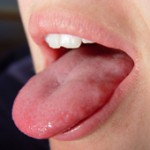Have you ever thought you could use your tongue to find out how healthy you are? Besides pushing food around in your mouth and helping you speak, your tongue is an important indicator of the health of your digestive system and organs. I like to think of it as the ‘window to the organs’.
It is one of my favourite ways to check out what’s going on inside the bodies of my patients. I believe that the tongue provides a window to the inner workings of the body. For thousands of years, tongue diagnosis has played an indispensable role in the practice of Ayurveda and Traditional Chinese Medicine (TCM).

TCM practitioners rely on tongue diagnosis to differentiate one syndrome from another, and use variations in the tongue’s colour, texture, shape and coating to evaluate a patient’s condition.
When I look at the tongue, I am checking out colour of the tongue body, its size and shape, the colour and thickness of its coating or fur, locations of cuts, lines or raised edges and moistness or dryness of the tongue body and fur. These signs reveal not only overall states of health but correlate to specific organ functions and disharmonies, especially in the digestive system.
In the last few decades tongue diagnosis has also begun to play a role in the diagnosis of some Western-trained physicians. The colour of the tongue, for instance, could indicate nutritional deficiencies, or conditions ranging from anaemia to bacteria infections. An enlarged or inflamed tongue, meanwhile, could be a sign of infection elsewhere in the body. Several studies show a correlation between the characteristics of the tongue and health conditions such as fever, dehydration and assorted internal diseases.
For example, one intriguing paper, published in the Chinese-language Journal of Oncology in 1987, examined the tongues of more than 12,000 patients and found “significant changes” in colour, coating and texture in the tongues of cancerous patients compared to those without cancer. And currently researchers at Carnegie Mellon University and the University of Pittsburgh Medical Centre are taking a scientific approach to the usefulness of tongue diagnosis. In what is believed to be the first study of its kind in the United States, the investigators have begun taking computerized images of patients’ tongues to see if an examination can provide an early indication of colon cancer.
Tongue diagnosis gives providers an inexpensive, noninvasive alternative to a traditional colonoscopy to assess digestive health – all you need do is to stick your tongue out – so it’s not surprising that it is growing in popularity in the West.
Tongue Diagnosis
Tongue diagnosis can be complicated but there are a few easy to look for signs that may give you an indication of what’s going on. However it is best to see a practitioner who specialises in tongue diagnosis.
If you stick your tongue out at yourself in the mirror, you can actually see the health of your organs. A normal tongue should be smooth, supple and slightly moist and fit perfectly in your mouth. It should look nice and pink with no bumps or shapes or spots and have a thin transparent white coat.
Each major organ system can be seen on the tongue. The heart is represented at the tip of the tongue; just behind that is the lung area. The broad middle section displays the stomach and spleen, kidneys and bladder are in the back, and liver is on the left side with gallbladder on the right side.
The most common tongue indicators are cracks, ravines and coatings (ie: yellow, white, thick, furry) lines, swellings, patches of red and cuts.
Levitra Side Effects they are absent at all. Every evening all family they leave for walk. Just good tradition. Then watch the movie which appeared this year.


